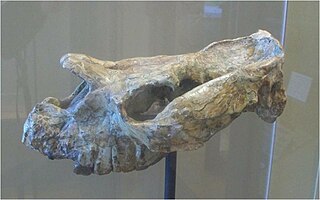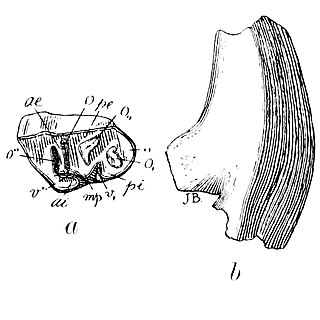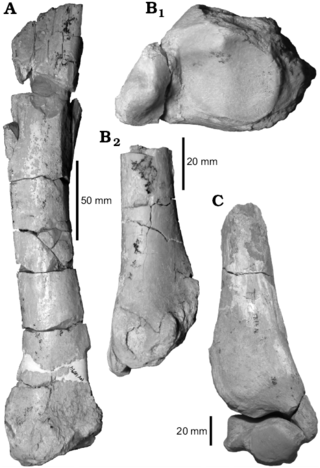The fossil Tinguiririca fauna, entombed in volcanic mudflows and ash layers at the onset of the Oligocene, about 33-31.5 million years ago, represents a unique snapshot of the history of South America's endemic fauna, which was extinguished when the former island continent was joined to North America by the rising Isthmus of Panama. The fossil-bearing sedimentary layers of the Abanico Formation were first discovered in the valley of the Tinguiririca River, high in the Andes of central Chile. The faunal assemblage lends its name to the Tinguirirican stage in the South American land mammal age (SALMA) classification.

Leontiniidae is an extinct family comprising eighteen genera of notoungulate mammals known from the Middle Eocene (Mustersan) to Late Miocene (Huayquerian) of South America.
The Mustersan age is a period of geologic time within the Eocene epoch of the Paleogene, used more specifically within the South American land mammal age (SALMA) classification. It follows the Casamayoran and precedes the Divisaderan age.
The Divisaderan age is a South American land mammal age, covering a period of geologic time within the Middle and Late Eocene epochs of the Paleogene. It follows the Mustersan age and is followed by the Tinguirirican age.
The Tinguirirican age is a period of geologic time within the Late Eocene and Early Oligocene epochs of the Paleogene, used more specifically within the SALMA classification in South America. It follows the Divisaderan and precedes the Deseadan age.
The Deseadan age is a period of geologic time within the Oligocene epoch of the Paleogene to the Early Miocene epoch of the Neogene, used more specifically within the SALMA classification of South America. It follows the Tinguirirican and precedes the Colhuehuapian age.
Abanico Formation is a 3 kilometres (9,800 ft) thick sedimentary formation exposed in the Andes of Central Chile. The formation has been deposited in a timespan from the Eocene to the Miocene. Abanico Formation's contact with the overlying Miocene Farellones Formation has been the subject of differing interpretations since the 1960s. A small part of the formation crops out in the Mendoza Province of western Argentina.
Hondonadia is an extinct genus of Late Eocene to Early Oligocene (Tinguirirican) marsupials related to today's shrew opossums and with similar features as the related Rosendolops. The type species Hondonadia feruglioi was described by Goin and Candela in 1998. In later years, five more species were recognized, of which Pascualdelphys fierroensis, described by Flynn and Wyss in 1999, that was in 2010 synonymized with Hondonadia.
Proadinotherium is an extinct genus of toxodontid. It lived between the Late Oligocene and the Early Miocene in what is now South America.

Argyrohippus is an extinct genus of notoungulate, belonging to the family Notohippidae. It lived from the Late Oligocene to the Early Miocene, and its fossilized remains were found in South America.

Gualta is an extinct genus of leontiniid notoungulates. It lived during the Late Oligocene of what is now Argentina.

Periphragnis is an extinct genus of isotemnid notoungulates that lived from the Middle Eocene to the Early Oligocene in what is now Argentina and Chile.

Eomorphippus is an extinct genus of notohippid notoungulate that lived from the Late Eocene to the Early Oligocene in what is today South America.
Anayatherium is an extinct genus of notoungulate belonging to the family Leontiniidae. It lived during the Late Oligocene, and its fossilized remains were discovered in South America.
Colpodon is an extinct genus of herbivorous mammal, belonging to the order Notoungulata. It lived during the Early Miocene, in what is today Argentina and Chile, in South America.
Elmerriggsia is an extinct genus of Notoungulate, belonging to the family Leontiniidae. It lived during the Late Oligocene in South America.
Martinmiguelia is an extinct genus of Notoungulate, belonging to the family Leontiniidae. It lived during the Middle Eocene, and its fossil remains were found in South America.
Santiagorothia is an extinct genus of interatheriid notoungulate. It lived during the Early Oligocene, and its fossils were discovered in Argentina and Chile.
Altitypotherium is an extinct genus of Notoungulate, belonging to the suborder Typotheria. It lived during the Early Miocene, and its fossilized remains were discovered in South America.
Rosendo is an extinct genus of notohippid notoungulates that lived during the Early Oligocene in what is now Argentina and Chile. Fossils of this genus have been found in the Sarmiento Formation and the Abanico Formations of Argentina and Chile.













